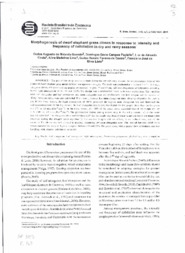Morphogenesis of dwarf elephant grass clones in response to intensity and frequency of defoliation in dry and rainy seasons.
Morphogenesis of dwarf elephant grass clones in response to intensity and frequency of defoliation in dry and rainy seasons.
Autoria: GOMIDE, C. A. de M.; PACIULLO, D. S. C.; COSTA, I. de A.; LIMA, A. M.; CASTRO, C. R. T. de; LEDO, F. J. da S.
Resumo: The aim of this study was to evaluate during the dry and rainy seasons the morphogenesis traits of two clones of dwarf elephant grass under different management strategies. The study was conducted in a factorial 2 × 2 × 3 design, using two clones, one green and one purple, two residual heights, 25 and 45 cm, and three frequencies of defoliation according to the light interception of 90, 95 and 100%. The design was a randomized block with three replications. The variables were leaf elongation and leaf senescence rate, stem elongation rate and phyllochron. The leaf lifespan and the number of living leaves per tiller were also estimated. The clones presented low stem elongation rates, showing adaptation for grazing use. In the rainy season, the light interception of 100% promoted the highest stem elongation rate and increased the leaf senescence rate. In the dry season, the leaf elongation rate (LER) was higher for the purple clone than for the green one (23 vs 15 mm.tiller-1.day-1). In the rainy season, the LER of the green clone exceeded that of the purple one by 71% (149 vs. 87 mm.tiller-1.day-1). The phyllochron varied among clones only in the rainy season, when the value was 4.6 days.leaf-1 for the green clone and 8.4 days.leaf-1 for the purple one; both of these values are below the mean value observed during the drought (21,6 days.leaf-1). The residual heights did not affect, in an isolated way, any of the variables. The clones are well adapted to grazing, presenting low stem elongation rates. The interval between defoliations should consider the scope of light interception between 90 and 95%. The green clone, with a greater flow of biomass, requires handling with shorter defoliation intervals.
Ano de publicação: 2011
Tipo de publicação: Artigo de periódico
Unidade: Embrapa Gado de Leite
Palavras-chave: Leaf elongation, Leaf senescence, Light interception, Pennisetum Purpureum, Phyllochron
Observações
1 - Por padrão são exibidas publicações dos últimos 20 anos. Para encontrar publicações mais antigas, configure o filtro ano de publicação, colocando o ano a partir do qual você deseja encontrar publicações. O filtro está na coluna da esquerda na busca acima.
2 - Para ler algumas publicações da Embrapa (apenas as que estão em formato ePub), é necessário ter, no celular ou computador, um desses softwares gratuitos. Sistemas Android: Google Play Livros; IOS: iBooks; Windows e Linux: software Calibre.
Acesse outras publicações
Acesse a Base de Dados da Pesquisa Agropecuária (BDPA) para consultar o acervo completo das bibliotecas da Embrapa.

